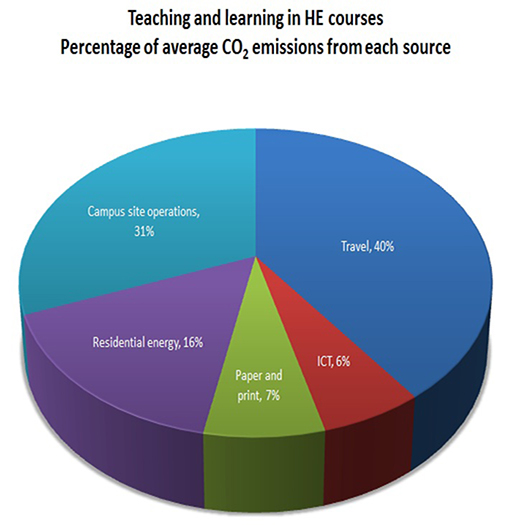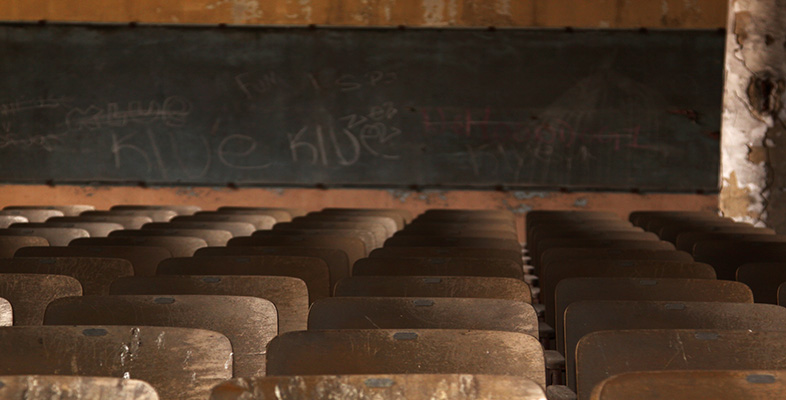4.3 Types of teaching models used in higher education and their environmental impacts
So how is the use of ICTs changing teaching models in higher education? A teaching model is defined by the primary way that teaching, learning and assessment is delivered to students on a course or module within a qualification programme. The use of ICTs is changing teaching and leading to pedagogical innovation.
In some cases, traditional face-to-face and even distance teaching methods are being replaced with radically new online learning designs. For example, some institutions are publishing and/or developing courses based on openly licensed online education resources (OERs), such as much of the content on OpenLearn [Tip: hold Ctrl and click a link to open it in a new tab. (Hide tip)] ; other institutions are now offering the free-to-join massive open online courses (MOOCs) that support global online learning communities and help learners to contribute to producing educational resources and services. (The Open University is developing MOOCs in collaboration with several other UK universities through the Futurelearn platform).
Other, less radical, approaches blend online teaching with traditional approaches to create new hybrid teaching models.
SAQ 8
What type of teaching model broadly describes your experience of providing teaching, learning and assessment provision? Do you mainly use face-to-face teaching or distance teaching methods or ICTs for some of this provision? Or does it use a blend of these methods?
Answer
You can compare your own thoughts with the classification developed within the SusTEACH project and the list below to describe the main approach to delivering teaching, learning and assessment.
Here is a simplified classification of teaching models used in HE, based on the primary teaching delivery methods:
- The face-to-face teaching model uses mainly face-to-face teaching methods with no ICT enhancement.
- The ICT-enhanced face-to-face teaching model uses face-to-face teaching methods enhanced by some use of ICTs, e.g. to provide online links to downloadable resources.
- The distance teaching model uses mainly traditional distance teaching methods such as using printed educational materials with supported learning, and has little or no ICT enhancement.
- The ICT-enhanced distance teaching model uses traditional distance teaching methods enhanced by some use of ICTs, e.g. to provide online links to downloadable resources or audio-visual digital resources such as CDs or DVDs.
- The online teaching model provides mainly online teaching, learning and assessment, available on the course or module’s VLE. The model may include some face-to-face teaching (such as attending day schools), but it is mainly an online provision.
The pervasiveness and potential applications for using ICTs in higher education raises questions about whether the greater use of ICTs for teaching and learning provision has better or worse environmental impacts than more traditional teaching models. This was why the SusTEACH project examined the role of ICTs in HE teaching models and their effect on carbon reduction. This study involved a carbon-based environmental assessment and data analysis of 30 courses across UK institutions, representing a range of teaching models.
You should now watch a short video with Dr Sally Caird that introduces the SusTEACH sustainable teaching and learning project.
Transcript: The SusTEACH project
In recent years, the use of Information and Communication Technologies or ICTs has become increasingly pervasive leading to more innovative, online models of teaching and learning across higher education. This raises questions about whether the greater use of ICTs in higher education teaching has better or worse environmental impacts than more traditional face-to-face and distance teaching models?
The SusTEACH project examined the role of ICTs in Higher Education Teaching Models and their effect on carbon reduction. This involved a carbon-based environmental assessment and data analysis of 30 courses and modules across UK institutions representing a range of teaching models. We conducted an environmental assessment of the key sources of carbon impacts associated with higher education teaching and learning. This included staff and student travel; purchase and use of educational materials and ICT devices; residential energy consumption; and campus site operations.
As with the Factor 10 study we found that the main sources of carbon impacts were associated with travel, residential energy consumption and campus site operations. However, the use of online and ICT-enhanced teaching delivery methods as well as traditional distance teaching methods reduced these sources of energy consumption and therefore achieved significant carbon reductions.
Building on the findings and methodology, we developed the innovative SusTEACH toolkit, which is designed to support the planning of more sustainable courses, modules and qualification programmes.
Presenter: Dr Sally Caird, The Open University
Further information: SusTEACH toolkit http://www9.open.ac.uk/ SusTeach/
The SusTEACH project team: Andy Lane, Sally Caird and Ed Swithenby
The SusTEACH project collected and assessed data on the course-related activities of students and lecturers, using the approach to carbon assessment encapsulated in the Carbon Calculator tools (see Part 3). This covered the key sources of carbon impacts associated with higher education teaching, such as staff and student travel, the purchase and use of educational materials and ICT devices, residential energy consumption, and campus site operations.
This approach provided the average environmental impacts of a course, expressed using a standard measure of energy consumption (MJ) and CO2 emissions (kg) ‘per student per 10 CATS credits’, which is equivalent to 100 study hours. Lecturers’ assessments were used to classify the different types of teaching delivery models to allow further analysis and comparisons of environmental impacts across a range of HE teaching models.
SAQ 9
Based on what you have already learned in this course, what would you expect the relative contributions of travel, residential energy consumption, campus-based operations, paper and print materials, and ICT devices to the energy consumption and carbon impacts of HE teaching and learning?
Answer
SusTEACH found that the main sources of carbon impacts in HE Teaching Models were travel (40 per cent), residential energy consumption (16 per cent) and campus site operations (31 per cent). The impact of educational paper and print materials (7 per cent) and the purchase and use of ICTs (6 per cent) were lower.

Overall, SusTEACH found that the use of online and ICT-enhanced teaching delivery methods, as well as traditional distance teaching methods, reduced the key sources of energy consumption and therefore achieved significant carbon reductions. The lowest carbon emissions were achieved using an online teaching model and were on average 87 per cent lower than the face-to-face teaching model, which, compared with other teaching models, had the highest carbon impacts.
In the online teaching model the carbon impacts associated with the purchase and use of ICT devices were higher, as expected, although this was offset by lower overall impacts. The online teaching model had lower impacts associated with the reduced use of paper and printed materials and a dematerialisation effect of using ICTs, although this was not the main reason for the lower carbon impacts. The main reasons for the lower carbon impacts were due to:
- the reduced need for students to travel as part of their studies
- the reduced need for students to consume more energy in residences whilst living away from their usual home
- the reduced energy consumption per student associated with university site operations.
SusTEACH also found that distance education systems of HE teaching reduced these sources of energy consumption and therefore achieved an average of 83 per cent fewer CO2 emissions than campus-based systems. These results were similar to the findings from the Factor 10 study (Roy et al., 2005).
The key challenges when designing sustainable education are to:
- reduce the requirement for students to travel to classrooms using carbon-intensive modes of travel
- take additional residential accommodation away from home
- use campus facilities most efficiently.
The use of online, ICT-enhanced and distance teaching methods can reduce these sources of energy consumption and therefore help to significantly reduce carbon emissions.
